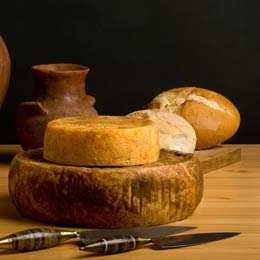The Villa de Valleseco still has a rural air of centuries ago. In fact one of its best known festivities is the Fiesta de la Manzana (Apple Festival) in honour of Nuestra Señora de La Encarnación, which is held on the first Sunday in October. The country people give thanks for the generosity of the land by offering up the harvest.
Another of the most popular festivities is that of San Vicente Ferrer, which is held fifty days after Easter Monday. It commemorates the day on which the saint left the Church in Teror bound for that of Valleseco, which was to be his church.
Other interesting festivities in the different neighbourhoods of Valleseco are San Luis Gonzaga (in Valsendero), at the end of June; Fiestas de Nuestra Señora de la Virgen del Carmen (Zumacal), in July; Fiestas de Santa Rosa de Lima (Lanzarote), in August; Fiestas de Santa Rita de Cassia (Madrelagua), also in July and the Fiestas de San José (in the centre of the village) in March.
The history of the municipality has its beginnings at the end of the 16th century, when the lands of the medianías (the name given in the Canary Islands to the land between the coast and the upper slopes of the mountains), were dealt out to outsiders who did not live in the municipality but owned large stretches of sugar cane in the coastal areas.

These irrigation crops required a large amount of water, as well as wood to refine them in the sugar refineries. This was how these owners took possession of the lands of the medianías, which were rich in forests and in water. They thus created an infrastructure to canalise the water which still exists today.
According to the Libro de Repartimientos (a sort of land register) the main benefactors of this process were, on the one hand, the Mayordomía del Pino de Teror (a kind of administrator) in the time of Charles III (1767) as payment for prayers and, on the other, some families such as the Troyas who originally came from Seville to these parts after the conquest.
However, the people who were responsible for working the land were not the owners themselves but the medianeros who settled in the area and who, in exchange for working the land, were given half the crops. These were the first inhabitants of Valleseco and it was they who began to write its history, first as a district within the municipality of Teror and later as a municipality in its own right.
It was then, in 1842, when Valleseco qualified to have a council of its own (in fact it is the youngest of the Gran Canaria municipalities). This was due mainly to the expansion of the village and the difficulty this incurred in communications, which was why it was preferable for it to become a separate parish and municipality.
From the end of the 19th century onwards, the village of Valleseco underwent hard times in which subsistence depended on the goodwill of the land. Agriculture and the rearing of a few animals were all families had to live on. It was a life full of hardship, in which survival required a great deal of hard work and ingenuity and which frequently forced many to emigrate - above all to Cuba and later to Venezuela - in search of a better life.
At an altitude of 1.000 metres above sea level, the municipality of Valleseco lies inland in the northern part of Gran Canaria. It covers just over 22 square kilometres and the village itself is about 7 kilometres from Teror.

It stands in a rugged landscape formed by two main barrancos (ravines), the Barranco de Madrelagua and the Barranco de la Virgen and a drier central valley, from which the municipality gets its name.
However, in spite of the name, Valleseco is a humid area once forming part of the great forest of laurisilva that covered the municipality at one time, as well as those of Teror, Firgas, Moya and parts of some other areas too.
The prominent feature of the municipality is its abundant vegetation. In fact, 80% of its territory is classed as a Protected Nature Area. Its importance as a natural area arises from the monteverde found everywhere, especially on the crags and most inaccessible areas.
The riches provided by Nature in Valleseco combine with the rural landscape typical of the northern medianías. The quality of the soil and the humid climate favour agriculture and stockbreeding, making it possible to offer the visitor excellent locally grown produce such as fruit, vegetables, and potatoes as well as cheese.


Besides, Valleseco is the municipality which receives the highest rainfall, so it is not surprising that water has been one of its main sources of wealth. This is why, since the early 19th century the municipality has created an extensive infrastructure to extract it and transport it to the surrounding land and to the coastal areas.